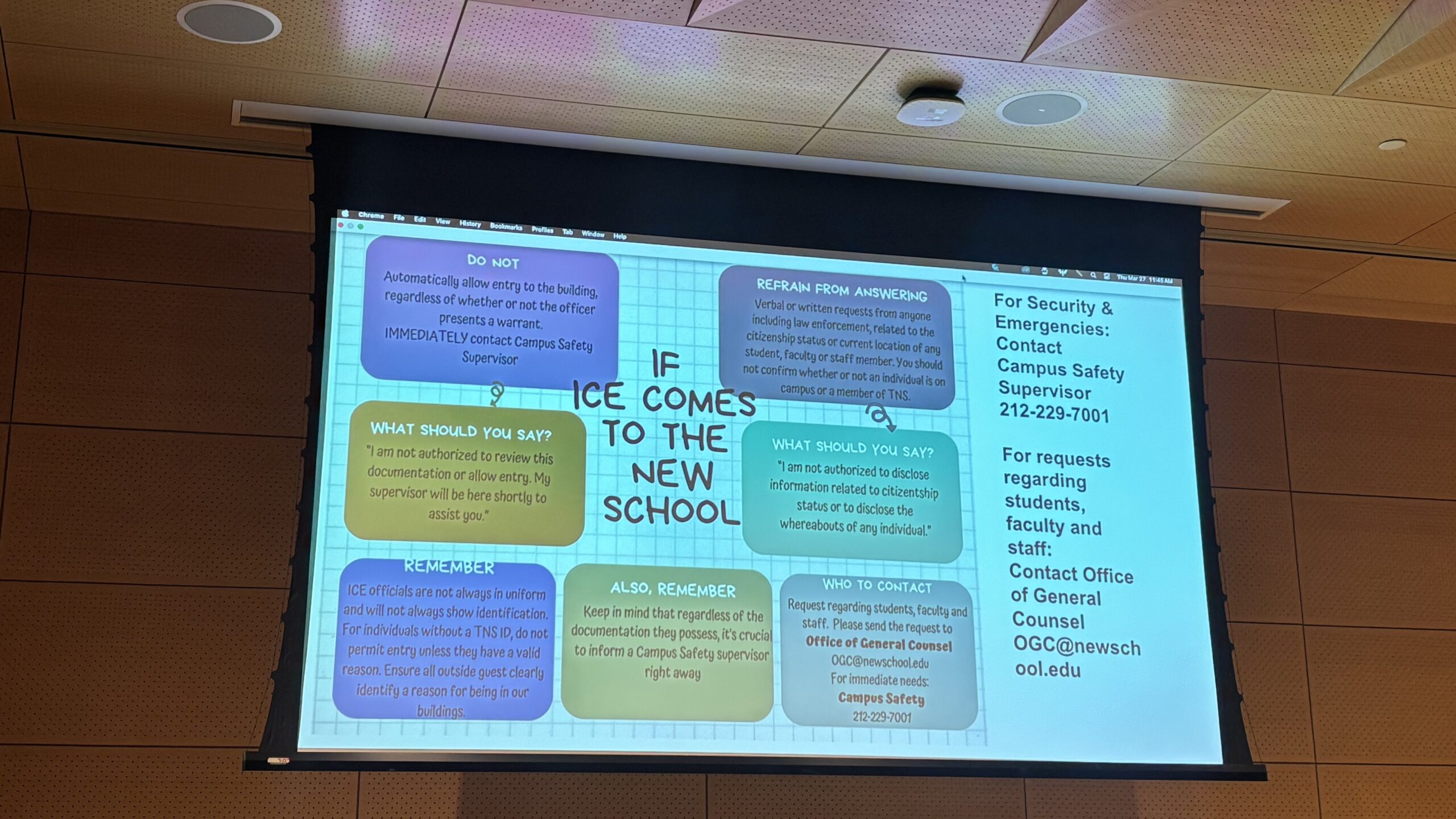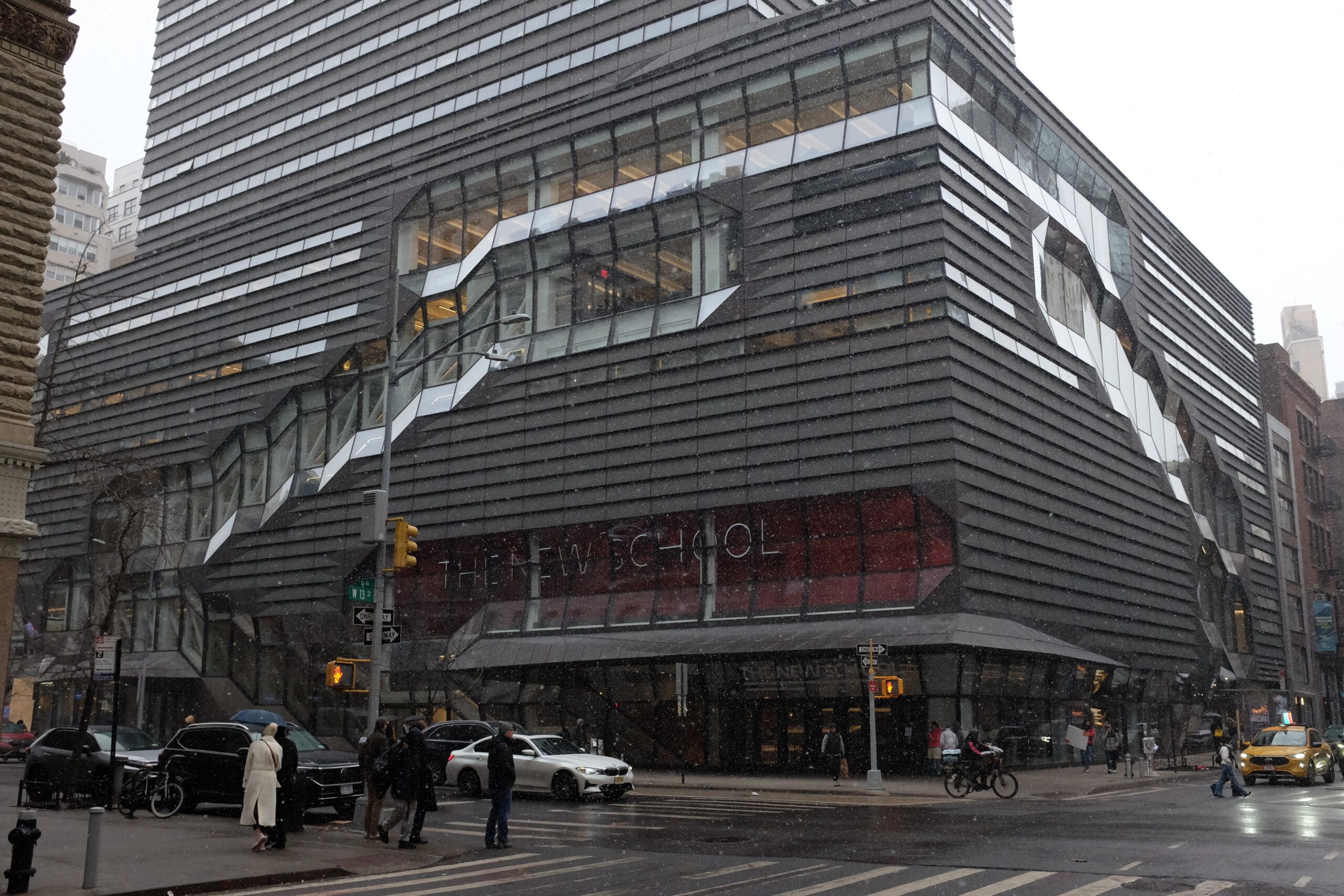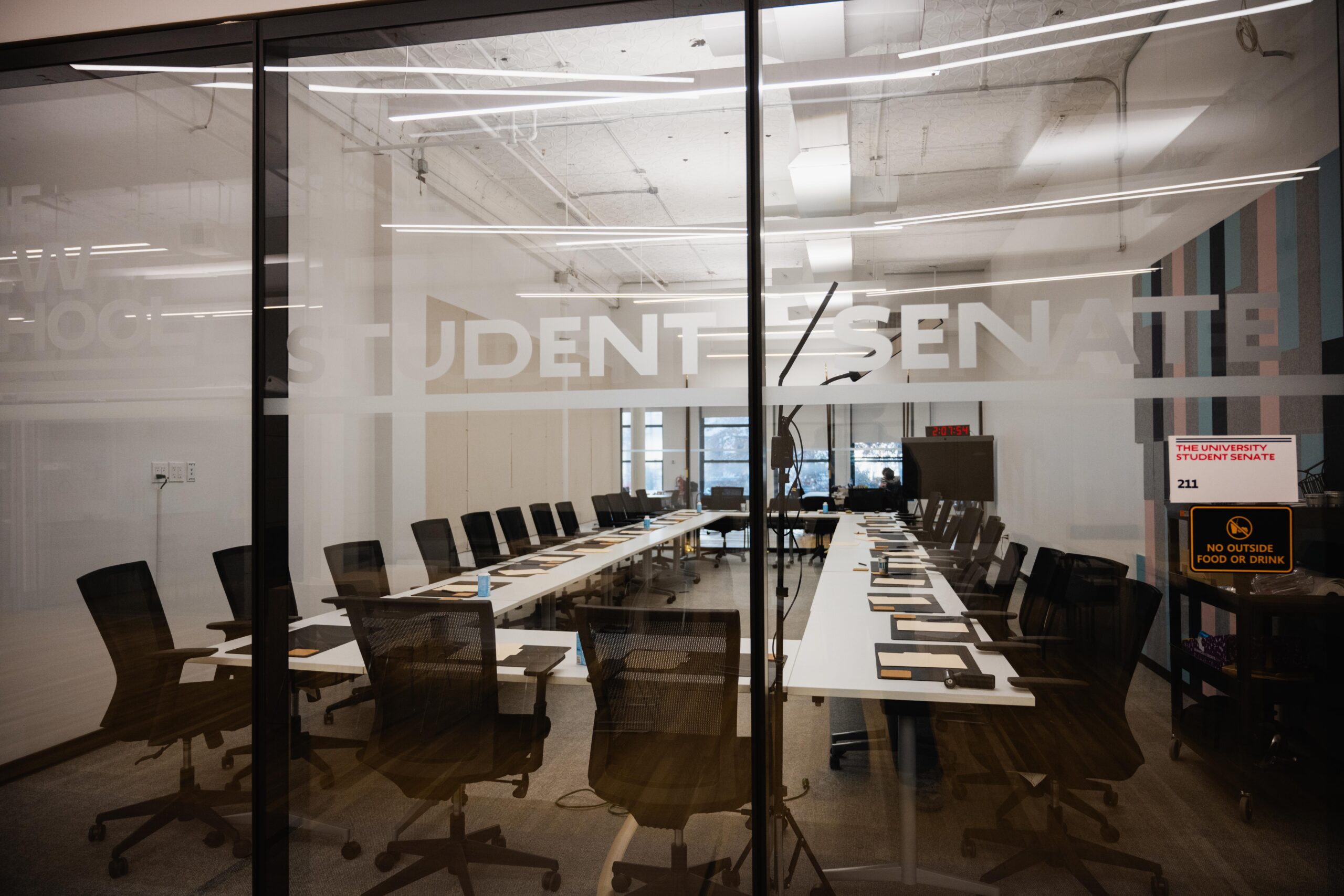Students Demand a Representative on the Board of Trustees
With reporting by Alexandra Ackerman, Danielle Balbi and Shawn Carrié
On April 10, 2009, around 5:30 a.m., dozens of students forced their way into the 65 Fifth Ave building using crowbars and bolt cutters. After driving out security, they chained the doors shut and hung a red-and-black flag off the rooftop, declaring the building occupied. Years of student anger and protest against what many in The New School community viewed as the university’s lack of transparency and student inclusion in administrative decisions had culminated in the second occupation in just under five months. After a seven hour stand-off with the police, the conflict ended with nearly two dozen students in handcuffs.
In the wake of the occupation, the embattled President Bob Kerrey — who had already received a no confidence vote from faculty — reiterated his commitment to following through with five agreed-upon demands from the earlier occupation. One of Kerrey’s promises, however, never came to fruition: student representation on the Board of Trustees.
For years prior, the idea had floated around among student activists and faculty. After the occupation in 2009, a special committee made up of several trustees, faculty members, students and administrators was formed to explore the issue. Though committee members voted unanimously in favor of having four student representatives on the board, the proposal was tabled by the board itself, which was undergoing a reorganization at the time.
In the years that followed, the idea continued to traverse the conversations of New School students, activists, and administrative student groups, yet hardly culminated into concrete action.
Now with David Van Zandt in his third year as president — a term that has been considerably less tumultuous than his predecessors — the call for student representation on the board, though dormant for years, has resurfaced among many students who believe that having student involvement at every echelon of the university is critical.
“If The New School is serious about creating a model of higher education rooted in values like social justice and civic engagement,” Chris Crews, a Ph.D candidate at NSSR and ACIR member, said, “it is unclear to me how excluding community voices from the board helps move us in that direction.”
Exacerbated by the fact that only minute details like trustees names are available online, meetings are unannounced and unreported, and little is known about their decision-making process, some students associate conspiratorial attributes to the board.
According to a sampling of 41 undergraduates, only one person surveyed felt that they had adequate knowledge of the board’s role at the university.
The board is comprised of 48 members who oversee operations and the financial standing of the institution. Each trustee is required to contribute at least $25,000 a year to the university and attend four annual meetings. Members include philanthropists, entrepreneurs and educators. There are currently seven alumni on the board, a number which some trustees, and particularly President Van Zandt, would like to see increase.
*****
In the coming months, the University Student Senate plans to draft a proposal for student representation on the board. During their Saturday, October 6 meeting, student senators expressed interest in pushing the issue to the forefront. Representatives of the Graduate Faculty Student Senate have echoed a similar interest in prioritizing the issue. But the chairman of the board, Joseph Gromek, is not so willing.
Though now and in the past he told the Free Press that he values student participation and thinks students should be present at all meetings, he opposes the idea of having a student sitting on the board.
“I’m not sure the students are going to get out of it what they want, and I don’t think the trustees are going to get much out of it either.”
He said that he has never been approached by students with a proposal and has not heard the issue discussed by other trustees.
“In the last three years, since I joined the board,” Gromek continued, “I have not heard a discussion that focused on student representation.”
President David Van Zandt, however, told the Free Press that the issue periodically arises at board meetings, particularly during Committee of Trusteeship meetings, whose job it is to nominate new trustees and review current ones. “It came up the last meeting we had,” he said.
“I think it is fair to say that some people are ranged on a continuum from strong support to strong opposition.”
Van Zandt said any proposal would ultimately have to be voted for by the trustees. But he could see an upside to student representation. Students, he said, have a vested interest in the long-term success of their university. Further, students bring a different perspective to the table.
On the other hand, he said, students come with a narrow perspective of the university’s management. “They’ve only seen so much, they only know so much about the school, they haven’t been here that long, and you don’t want people on the board who have an axe to grind, or who are one issue people.”
Jens Astrup, USS co-chair, thinks a student on the board is necessary.
“We’re not going to be some frontier by having a student member of the Board of Trustees,” he said. “It’s already been done before [at other universities].”
Gromek said that since his tenure began as chairman last year, he has been working to increase student involvement with the board. All meetings now include student presentations and students are often invited to social gatherings with trustees as well. But there are no students consistently at each meeting and often the students present do not hold a leadership role in the university.
On occasion, the board has had the University Student Senate and the University Faculty Senate present proposals, and Gromek said he would be open to meeting with student leaders on a more regular basis through establishing other formal channels.
Astrup said that’s a nice proposition, but not quite what the students want. According to Astrup and others, students need to be aware of what is happening at every echelon of the university, and should be directly involved in the decision-making process. “That’s a nice step towards student representation but I don’t think it’s a substitute for it,” he said.
What exactly student representation would look like on the New School board is unclear.
After the student occupation in 2009, Kerrey told the Free Press that the terms of an agreement were still undecided. “We’re trying to create as many legitimate avenues of protest and engagement and involvement with the decision-making of the university as possible including an active evaluation of how — not if, but how — to get a student representative on the Board of Trustees,” he said.
Some students would like to see representatives from each division. Many other universities have student representatives sitting on a variety of committees.
Chris Harris, speaker of the New School for Social Research’s Graduate Faculty Student Senate, feels that there would at least need to be representatives from the graduate and undergraduate student body. “If the student representative were to be proposed as a silent observer at these meetings, then I suppose it wouldn’t really matter who attended,” he continued, “but since I imagine this person having a more active role, it makes very little sense to have someone unfamiliar with graduate life in general, and at NSSR in particular, speak on our behalf.”
Some students, like Dale Morgan, a university student senator, believe that power at an institution that claims to be progressive, like the New School, should rest primarily in the hands of students. He and several other students recently formed the Radical Student Union, demanding that students have a place on the board. “The only solution that serves the community is to demand student control and oversight of the Board and school,” their proposal reads. “We therefore propose that the majority of the board’s voting members be elected student representatives.”
A student-led board would be unprecedented, but over the past decade, increasing numbers of universities have incorporated student representation into their boards. According to the Association of Governing Boards, about 70 percent of public institutions and 20 percent of private institutions have at least one sitting student representative, and many have multiple representatives serving on different committees.
“Asking for several students to be formally added to the Board of Trustees is hardly a radical request, and is standard practice at universities across the country,” said Crews.
Student members on boards at other universities emphasized the benefits of student representation. “Having student representation on the board benefits the student body because it increases transparency,” said Julia Susuni, student president at George Washington University, who often presents reports to the board’s Committee on Student Affairs. “It also allows the Board to receive student input in a more formal way, which then sparks follow up conversations that may take place in an informal setting with the student representative.”
Jack Stripling, a journalist for The Chronicle on Higher Education, said that schools are increasingly finding the inclusion of student representatives important for the student body, but also for the trustees. “Students bring a perspective that is often missing from the conversation,” he said. “These are the very people, after all, who will shoulder the burden of any tuition and fee increases a board may approve.”
But others argue that precisely because students shoulder the tuition, it would be a conflict of interests for them to also sit as voting members of boards. The Association of Governing Boards, which represents the boards of 1,250 universities, officially opposes student membership, claiming that boards must be somewhat distant from the institution they represent, so as to allow for rational business decisions.
“A college can rationally argue that the best stewards of an institution are those at some remove from the college with proven skills and wisdom in myriad arenas,” said Stirpling. “It usually doesn’t hurt if they have some money, too.”
And whether or not students should have the right to vote is a contested issue nationally, even at schools where there are sitting student board members. Susuni told the Free Press that the issue has been a point of tension with George Washington University’s administration, where student representatives, including Susuni, sit through board meetings and contribute to the conversation but do not vote.
“I think that many students are generally frustrated that students don’t have any voting opportunities on the board,” she said. “It has been something that comes up every year, but not something that we have been able to get much movement on.”
But Ronald Gordon Ehrenberg, an economics professor who has written extensively on the importance of faculty and student participation on boards, and sits as a faculty member on Cornell University’s Board of Trustees, does not think it is important whether students are able to vote. “Whether or not the student trustee has a formal vote really does not matter that much,” he said, noting that, at least at his university, trustees tend to vote unanimously on resolutions. “But it is important for board members to know student views on issues.”
Many proponents of student representation admit that the school is a different institution than it was during Kerrey’s era. Students and faculty members interviewed for this article agreed that the new administration has made strides to increase transparency and incorporate student voices into decision-making processes. Several trustees now work alongside students and faculty in the Advisory Committee on Investor Responsibility, a council that formed after the first occupation.
But for many students, faculty, and even administrators, the discussion about student representation remains as relevant now as ever.
“Instead of a reaction to whatever was happening,” Van Zandt said, “it’s relevant on its own merits today. [It’s a question of] whether it makes sense for the university to have its governance structured that way.”








Leave a Reply